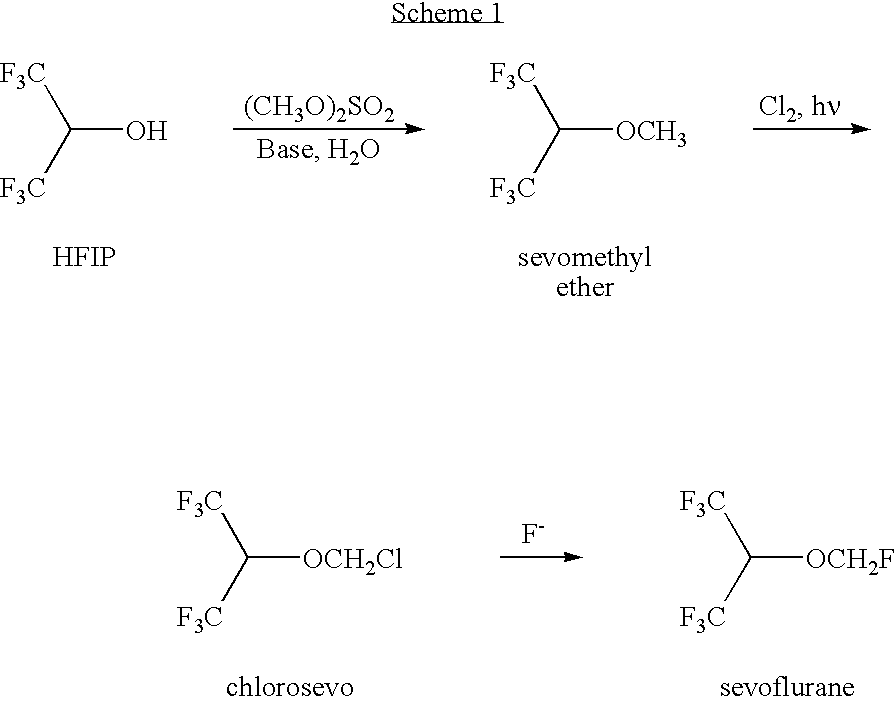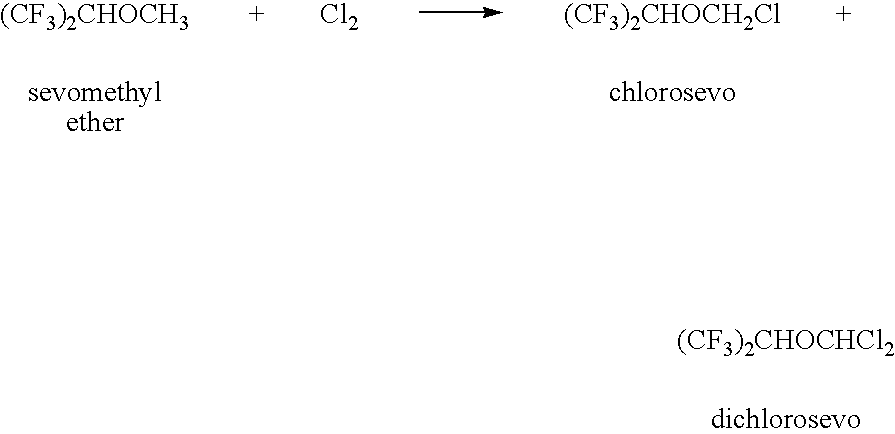Process for recovery of 1,1,1,3,3,3-hexafluoroisopropanol from the waste stream of sevoflurane synthesis
a technology of hexafluororoisopropanol and sevoflurane, which is applied in the field of recovery of 1,1,1,3,3,3hexafluoro2propanol, can solve the problems of reducing the efficiency of the sevoflurane preparative process, inefficiency of the process, and loss of the overall yield of the process
- Summary
- Abstract
- Description
- Claims
- Application Information
AI Technical Summary
Benefits of technology
Problems solved by technology
Method used
Image
Examples
example 1
Hydrolysis of a Chlorosevo-Depleted Mixture containing HFIP Hydrolyzable Precursors and Recovery of HFIP
[0071] The chlorination of sevomethyl ether yielded a reaction mixture that was worked up by aqueous extraction followed by distillation to isolate chlorosevo and unreacted sevomethyl ether. The remaining stillpot residue is referred to herein as Mixture A. Gas chromotography (GC) analysis of the Mixture A revealed a complex mixture of halogenated compounds. Identified among these halogenated compounds were chlorosevo (37.3%), dichlorosevo (14.6%), and di-HFIP acetal (32.3%). Mixture A also contained droplets of water and some solid inclusions.
[0072] A hydrolysis mixture was prepared by combining equal volumes of Mixture A (65 mL, 100.0 g) and concentrated sulfuric acid (65 mL, 119.6 g). The mixture was kept under reflux for 18 hours. The resulting two-phase, dark-brown reaction mixture was subjected to distillation to provide 66.8 g of a clear liquid, bp 50-63° C. According to ...
example 2
Effect of the Proportion of Sulfuric Acid on the Hydrolysis of a Chlorosevo-Depleted Mixture containing HFIP Hydrolyzable Precursors and the Recovery of HFIP
[0074] In this example, the effect of the proportion of the strong protic acid, H2SO4, on the hydrolysis of Mixture A (described in Example 1), and on the recovery of HFIP was evaluated.
[0075] In each of 4 trials, Mixture A (100 g) and concentrated sulfuric acid were combined in the volume ratios shown in Table 1. Each of the reaction mixtures in the trials was heated at reflux for 18 hours, and the mixtures were distilled to provide distallates having the weights and composition as shown in Table 1.
TABLE 1Volume ratiostartingCrudeMixture A / DistilledSevomethylDi-HIFIPTrial #sulfuric acidProduct, gether %acetal %HFIP %Unknown %14:152.72.115.467.115.822:165.41.39.087.71.631:166.80.610.688.4041:267.90.45.693.30
[0076] The results in Table 1 demonstrate that higher proportions of sulfuric acid provide higher recoveries of HFIP. H...
example 3
Evaluation of the Efficiency a Single Charge of Sulfuric Acid in Repeated Hydrolysis Trials
[0077] In this example, the hydrolytic efficiency of a single charge of sulfuric acid was evaluated over the course of five trials. In each of the five trials, a fresh 100 g (65 mL) charge of Mixture A (described in Example 1) was used. In trial 1, a fresh charge of concentrated sulfuric acid (65 mL, 119.6 g) was combined with the Mixture A and the resulting mixture was heated at reflux for 18 hours. After distillation of the hydrolyzed mixture, the pot residue was cooled to room temperature, and a fresh charge of Mixture A was added to the pot residue. Heating and recovery of the crude hydrolysis product followed. These iterations were repeated three more times. The weight and composition of the crude distilled product is shown in Table 2.
TABLE 2Pot temp,Pot temp,at whichat whichdistillationdistillationwasDi-started,stopped,sevomethylHFIPUnknown,Charge° C.° C.Producut, gether, %Acetal, %HF...
PUM
| Property | Measurement | Unit |
|---|---|---|
| Temperature | aaaaa | aaaaa |
| Percent by volume | aaaaa | aaaaa |
| Temperature | aaaaa | aaaaa |
Abstract
Description
Claims
Application Information
 Login to View More
Login to View More - R&D
- Intellectual Property
- Life Sciences
- Materials
- Tech Scout
- Unparalleled Data Quality
- Higher Quality Content
- 60% Fewer Hallucinations
Browse by: Latest US Patents, China's latest patents, Technical Efficacy Thesaurus, Application Domain, Technology Topic, Popular Technical Reports.
© 2025 PatSnap. All rights reserved.Legal|Privacy policy|Modern Slavery Act Transparency Statement|Sitemap|About US| Contact US: help@patsnap.com


